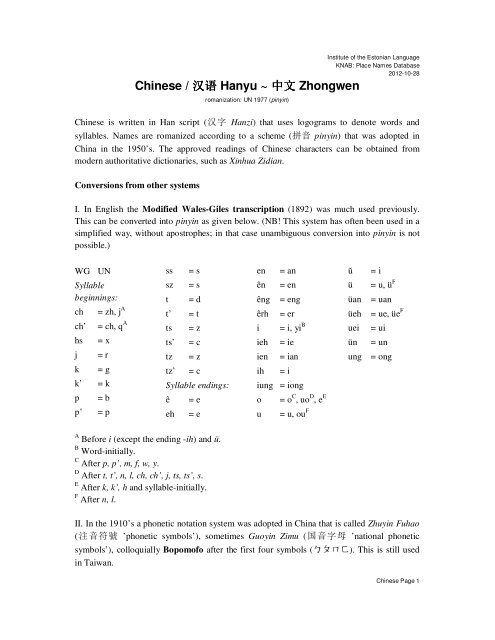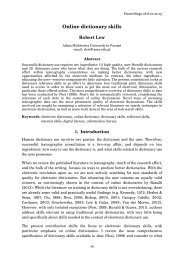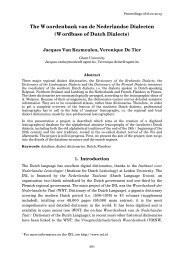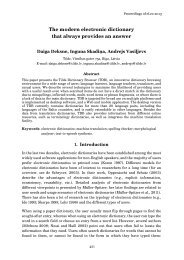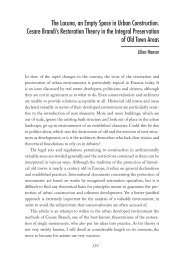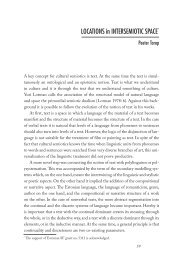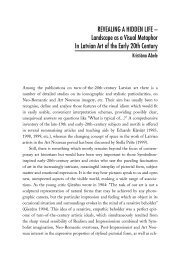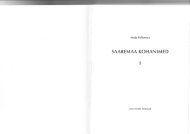Chinese / 汉语 Hanyu ~ 中文 Zhongwen - Eesti Keele Instituut
Chinese / 汉语 Hanyu ~ 中文 Zhongwen - Eesti Keele Instituut
Chinese / 汉语 Hanyu ~ 中文 Zhongwen - Eesti Keele Instituut
Create successful ePaper yourself
Turn your PDF publications into a flip-book with our unique Google optimized e-Paper software.
<strong>Chinese</strong> / <strong>汉语</strong> <strong>汉语</strong> <strong>Hanyu</strong> ~ <strong>中文</strong> <strong>中文</strong> <strong>Zhongwen</strong><br />
romanization: UN 1977 (pinyin)<br />
Institute of the Estonian Language<br />
KNAB: Place Names Database<br />
2012-10-28<br />
<strong>Chinese</strong> is written in Han script (汉字 Hanzi) that uses logograms to denote words and<br />
syllables. Names are romanized according to a scheme (拼音 pinyin) that was adopted in<br />
China in the 1950’s. The approved readings of <strong>Chinese</strong> characters can be obtained from<br />
modern authoritative dictionaries, such as Xinhua Zidian.<br />
Conversions from other systems<br />
I. In English the Modified Wales-Giles transcription (1892) was much used previously.<br />
This can be converted into pinyin as given below. (NB! This system has often been used in a<br />
simplified way, without apostrophes; in that case unambiguous conversion into pinyin is not<br />
possible.)<br />
WG UN<br />
Syllable<br />
beginnings:<br />
ch = zh, j A<br />
ch’ = ch, q A<br />
hs = x<br />
j = r<br />
k = g<br />
k’ = k<br />
p = b<br />
p’ = p<br />
ss = s<br />
sz = s<br />
t = d<br />
t’ = t<br />
ts = z<br />
ts’ = c<br />
tz = z<br />
tz’ = c<br />
Syllable endings:<br />
ê = e<br />
eh = e<br />
A<br />
Before i (except the ending -ih) and ü.<br />
B<br />
Word-initially.<br />
C<br />
After p, p’, m, f, w, y.<br />
D<br />
After t, t’, n, l, ch, ch’, j, ts, ts’, s.<br />
E<br />
After k, k’, h and syllable-initially.<br />
F After n, l.<br />
en = an<br />
ên = en<br />
êng = eng<br />
êrh = er<br />
i = i, yi B<br />
ieh = ie<br />
ien = ian<br />
ih = i<br />
iung = iong<br />
o = o C , uo D , e E<br />
u = u, ou F<br />
ŭ = i<br />
ü = u, ü F<br />
üan = uan<br />
üeh = ue, üe F<br />
uei = ui<br />
ün = un<br />
ung = ong<br />
II. In the 1910’s a phonetic notation system was adopted in China that is called Zhuyin Fuhao<br />
(注音符號 ’phonetic symbols’), sometimes Guoyin Zimu (国音字母 ’national phonetic<br />
symbols’), colloquially Bopomofo after the first four symbols (ㄅㄆㄇㄈ). This is still used<br />
in Taiwan.<br />
<strong>Chinese</strong> Page 1
ㄅ b-<br />
ㄆ p-<br />
ㄇ m-<br />
ㄈ f-<br />
ㄉ d-<br />
ㄊ t-<br />
ㄋ n-<br />
ㄌ l-<br />
ㄍ g-<br />
ㄎ k-<br />
ㄏ h-<br />
ㄐ j-<br />
ㄑ q-<br />
ㄒ x-<br />
ㄓ zh-<br />
ㄔ ch-<br />
ㄕ sh-<br />
ㄖ r-<br />
ㄗ z-<br />
ㄘ c-<br />
ㄙ s-<br />
ㄚ -a<br />
ㄛ -o<br />
ㄜ -e<br />
ㄝ -e (ê)<br />
ㄞ -ai<br />
ㄟ -ei<br />
ㄠ -ao<br />
ㄡ -ou<br />
ㄢ -an<br />
ㄣ -(e)n<br />
ㄤ -ang<br />
ㄥ -(e)ng<br />
ㄦ -er<br />
ㄧ -i<br />
ㄨ -u<br />
ㄩ -ü<br />
Notes<br />
1. Syllables ci, chi, si, shi, zi, zhi are written without syllable-finals.<br />
2. Tones are marked with the same symbols as in pinyin, except Tone 1 (¯ ) which is not<br />
marked. Light tone is marked with a dot before the syllable.<br />
3. Examples: ㄌㄨㄥˊ → lóng, ㄕㄢ・ㄉㄜ → shānde, ㄉㄧㄝ → diē, ㄋㄩˇ → nǚ, ㄑ<br />
ㄧㄠˇ → qiǎo, ㄧㄤ → yang, ㄐㄩㄝ → jue, ㄑㄩㄢˊㄌㄧˋ → quánlì, ㄧˇ・ㄗ →<br />
yǐzi.<br />
III. In Russian the Palladius transcription is used which was finalized mainly by 1888.<br />
Syllable beginnings:<br />
б b<br />
в w<br />
г g<br />
д d<br />
ж r<br />
к k<br />
л l<br />
м m<br />
н n<br />
п p<br />
с s, x A<br />
т t<br />
ф f<br />
х h<br />
ц c, q A<br />
цз z, j A<br />
ч ch<br />
чж zh<br />
ш sh<br />
Syllable endings:<br />
а a<br />
ай ai<br />
ан ang<br />
ань an<br />
ао ao<br />
е ie, ye*<br />
и i, yi*<br />
ин ing, ying*<br />
инь in, yin*<br />
о uo, o B<br />
ой E ui<br />
* As a separate syllable, without an initial consonant.<br />
A Before е, и, ю, я.<br />
B After б, в, м, п, ф and as a separate syllable.<br />
оу ou<br />
у u, wu*<br />
уа ua<br />
уай uai<br />
уан uang<br />
уань uan<br />
уй ui<br />
ун ong<br />
унь un<br />
уэй E ui<br />
ы i C<br />
ын E eng<br />
ынь E en<br />
э e<br />
эй ei<br />
эн eng<br />
энь en<br />
эр er<br />
ю iu, you*<br />
юань uan,yuan*<br />
юе F üe,ue D ,yue*<br />
юй ü,u D ,yu*<br />
юн iong,yong*<br />
юнь un,yun*<br />
юэ üe,ue D ,yue*<br />
я ia, ya*<br />
ян iang,yang*<br />
янь ian, yan*<br />
яо iao, yao*<br />
<strong>Chinese</strong> Page 2
C Syllable ды → dė.<br />
D After с (x), ц (q), цз (j).<br />
E Exceptional or traditional equivalent in some syllables, e.g. хой / хуэй → hui, мын → meng,<br />
мынь → men.<br />
F Obsolete transcription, nowadays юэ.<br />
Note. To indicate syllable boundaries, hard sign may be used, cf. фанань → fanan, фанъань<br />
→ fang’an.<br />
IV. In the 1950’s there was an attempt to devise an Estonian transcription of <strong>Chinese</strong> names<br />
and the instructions were published in 1957. This was abandoned in 1960 in favour of pinyin.<br />
If needed, the system might be used for adapting <strong>Chinese</strong> words into Estonian.<br />
Syllable beginnings:<br />
b = p<br />
c = tsh<br />
ch = tšh<br />
d = t<br />
g = k<br />
j = ts<br />
k = kh<br />
p = ph<br />
q = tsh<br />
r = ž<br />
sh = š<br />
t = th<br />
A In combinations ei and ie.<br />
B After c, ch, r, s, sh, z, zh.<br />
C After b, f, m, p.<br />
D After j, q, x, y.<br />
w = v<br />
x = s<br />
y = j<br />
z = ts<br />
zh = tš<br />
Full syllables:<br />
wu = u<br />
you = ju<br />
Syllable endings:<br />
ao = au<br />
e = õ, e A<br />
i = i, õ B<br />
ia = ja<br />
ian = jen<br />
iang = jang<br />
iao = jau<br />
ie = je<br />
iong = jung<br />
iu = jo(u)<br />
o = uo C<br />
ong = ung<br />
ou = ou<br />
u = u, ü D<br />
ui = uei<br />
un = uen?<br />
Sources<br />
1. Klaus Kaden, Die wichtigsten Transkriptionssysteme für die chinesische Sprache. Eine<br />
Einführung zum Selbststudium. VEB Verlag Enzyklopädie, Leipzig 1975.<br />
2. Juhiseid hiina nimede kirjutamiseks eesti keeles. – ENSV TA Toimetised, Üt. seeria 3-<br />
4/1957, lk 350-354.<br />
<strong>Chinese</strong> Page 3


